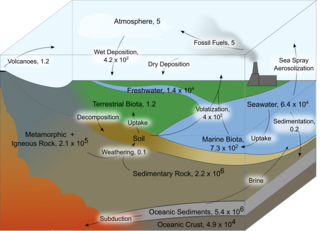Antioxidants are compounds that inhibit oxidation, a chemical reaction that can produce free radicals. Autoxidation leads to degradation of organic compounds, including living matter. Antioxidants are frequently added to industrial products, such as polymers, fuels, and lubricants, to extend their usable lifetimes. Foods are also treated with antioxidants to forestall spoilage, in particular the rancidification of oils and fats. In cells, antioxidants such as glutathione, mycothiol, or bacillithiol, and enzyme systems like superoxide dismutase, can prevent damage from oxidative stress.

Selenium is a chemical element; it has the symbol Se and atomic number 34. It has various physical appearances, including a brick-red powder, a vitreous black solid, and a grey metallic-looking form. It seldom occurs in this elemental state or as pure ore compounds in Earth's crust. Selenium was discovered in 1817 by Jöns Jacob Berzelius, who noted the similarity of the new element to the previously discovered tellurium.

Glutathione peroxidase (GPx) is the general name of an enzyme family with peroxidase activity whose main biological role is to protect the organism from oxidative damage. The biochemical function of glutathione peroxidase is to reduce lipid hydroperoxides to their corresponding alcohols and to reduce free hydrogen peroxide to water.

Iodised salt is table salt mixed with a minute amount of various salts of the element iodine. The ingestion of iodine prevents iodine deficiency. Worldwide, iodine deficiency affects about two billion people and is the leading preventable cause of intellectual and developmental disabilities. Deficiency also causes thyroid gland problems, including endemic goitre. In many countries, iodine deficiency is a major public health problem that can be cheaply addressed by purposely adding small amounts of iodine to the sodium chloride salt.

Glutathione peroxidase 1, also known as GPx1, is an enzyme that in humans is encoded by the GPX1 gene on chromosome 3. This gene encodes a member of the glutathione peroxidase family. Glutathione peroxidase functions in the detoxification of hydrogen peroxide, and is one of the most important antioxidant enzymes in humans.
Selenium deficiency occurs when an organism lacks the required levels of selenium, a critical nutrient in many species. Deficiency, although relatively rare in healthy well-nourished individuals, can have significant negative results, affecting the health of the heart and the nervous system; contributing to depression, anxiety, and dementia; and interfering with reproduction and gestation.

Iodine is an essential trace element in biological systems. It has the distinction of being the heaviest element commonly needed by living organisms as well as the second-heaviest known to be used by any form of life. It is a component of biochemical pathways in organisms from all biological kingdoms, suggesting its fundamental significance throughout the evolutionary history of life.

Selenium is an essential micronutrient for animals, though it is toxic in large doses. In plants, it sometimes occurs in toxic amounts as forage, e.g. locoweed. Selenium is a component of the amino acids selenocysteine and selenomethionine. In humans, selenium is a trace element nutrient that functions as cofactor for glutathione peroxidases and certain forms of thioredoxin reductase. Selenium-containing proteins are produced from inorganic selenium via the intermediacy of selenophosphate (PSeO33−).

Virginia Minnich (1910–1996) was an American molecular biologist and hematology researcher known for discovering hemoglobin E, an abnormal form of hemoglobin that can cause blood disorders, and for working out the glutathione synthesis pathway. She was a noted blood morphologist and teacher and helped set up hematology laboratories around the world. She was the first person without a PhD or MD to be appointed a Professor of Medicine at Washington University School of Medicine.
Sheila A. Skeaff is a Canadian-born New Zealand nutritionist and full professor at the University of Otago. Her research focusses on food literacy, sustainable diets and iodine deficiency.
Marion Frances Robinson was a New Zealand nutritionist and physiologist. She was professor of nutrition at the University of Otago, and is particularly noted for her investigation of the importance of selenium in the human diet.
Rachel C. Brown is a New Zealand scientist, professor and deputy head of the Department of Human Nutrition at the University of Otago.
Jane Coad is a New Zealand public health nutrition researcher and professor in nutrition at Massey University. She is co-director of Massey's Vitamin D Research Centre which she and Pam von Hurst founded in 2010.

Barbara Jean Francis Apgar is an American biochemist. She worked on important research on ribonucleic acids (RNA), and on zinc deficiency as a risk factor in reproduction. She won the Federal Woman's Award in 1970, and the Arthur S. Flemming Award in 1973.
Jayne Valerie Woodside is a British nutritionist who is Professor of Human Nutrition at the Institute for Global Food Security at Queen's University Belfast. Her research considers human nutrition intervention with whole foods. She is on the Board of Trustees of The Nutrition Society.
Peter Elwood is professor of epidemiology who for more than two decades led the Medical Research Council's Epidemiological Unit in South Wales. In 1979 he initiated the Caerphilly Heart Disease Study.

Lisa Anne Te Morenga is a New Zealand Maori academic, and she is a full professor at the Research Centre for Hauora and Health at Massey University. Her research focuses on nutrition and Māori health, especially in relation to dietary interventions to prevent metabolic disease.

Kathryn Louise Beck is a New Zealand academic, a registered dietitian, and is a full professor at Massey University, specialising in dietary assessment, sustainable nutrition, and iron deficiency in young women and sportspeople.

Cathryn Anne Conlon is a New Zealand academic, and is a full professor at Massey University, specialising in maternal and early-life nutrition.
Anne-Louise M. Heath is a New Zealand academic, and is a full professor at the University of Otago, specialising in baby and infant nutrition, including baby-led weaning and iron deficiency.











